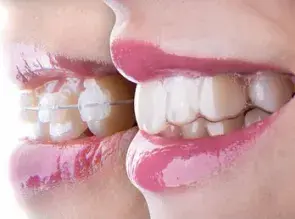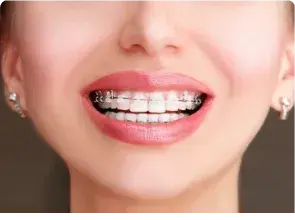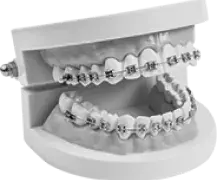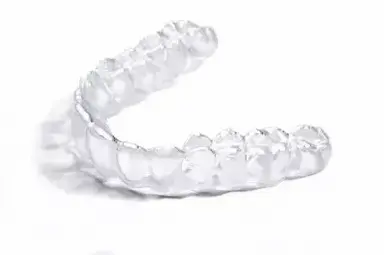braces
# what are braces?
Braces are a fusion of brackets and arch wires that help straighten crowded, crooked, or misaligned teeth. The brackets and wires of the teeth braces apply pressure to the teeth gradually shifting them to the desired position.

how do braces work?
Dental braces treatment works by applying gentle pressure to your teeth, slowly pushing or pulling them into an optimal position. It gradually reshapes the supporting bone as the pressure is applied. Braces treatment is designed to treat various misalignment issues, including teeth gaps and crooked teeth.
types of braces

metal braces
Metal dental braces are an orthodontic treatment that may help align crooked or overcrowded teeth. Metal braces also have an important role in improving oral health. They are permanently adhered to your teeth and can only be taken off at the end of the treatment.

Invisible Braces
Also known as transparent braces are made of materials like ceramic, porcelain or clear plastic. Most people won’t even know you have clear braces on! These invisible teeth braces or invisible dental braces are permanently affixed to the teeth and can only be removed at the end of the treatment.

Ceramic Braces
Ceramic braces are orthodontic tools made with a combination of wires and clear ceramic brackets that blend with the natural colour of the teeth making them less noticeable. These braces with ceramic brackets are less durable than traditional braces.

lingual braces
Lingual braces are a type of braces that consist of very small brackets attached to a wire that is placed behind the teeth, facing the tongue and palate, instead of in front of the teeth like traditional braces. These lingual dental braces are a great cosmetic alternative for those who want to straighten teeth without the visible metal brackets.
Fact check: brace yourself! ( Painful, Hygiene, Food and drink restrictions)
It’s painful
One has to tighten the metal braces occasionally, which can cause pain for a few days every month.
Cuts inside mouth
Braces can rub against the inside of your mouth, irritating the area and forming a sore or a cut. These braces problems can eventually lead to other infections as well.
yellow teeth
Another fact about braces is that consuming hard-stained food items like turmeric, tomato paste, and coloured candies may stain your braces
Food restrictions
Be mindful that braces are sensitive to damage, so one needs to avoid foods like caramel, soda, nuts, chips, chewing gum, etc.
oral hygiene
Braces make brushing and flossing difficult, leading to an increased risk of tooth decay and gum disease.
more visits to the orthodontists
braces require regular and multiple visits to the orthodontist for adjustments
Braces cost in India
Curious about braces cost in India? While the actual cost of braces treatment depends greatly on factors like complexity, the treatment duration and the material used, teeth braces cost you anywhere from Rs. 25,000 for traditional metal braces to up to Rs. 2 lakhs for lingual braces!
Clear teeth aligners by makeO toothsi, on the other hand, start at an EMI of just ₹3,019 per month! This in the longer run, proves to be much more feasible than what braces cost.
Not to forget that invisible aligners are much more comfortable than traditional braces, and are removable too.
say hello to invisible aligners!
Invisible braces, also known as transparent braces, are an alternative to traditional metal braces and are designed to guide teeth into their proper position. Clear braces use a gradual force to control tooth movement. makeO toothsi clear aligners are crafted from the best quality BPA-free plastic sheets which are US FDA approved. These 3D-printed aligners are customised as per your teeth. Your teeth and our aligners are always a #PerfectMatch.
Unlike metal braces, transparent braces give you freedom and many more reasons to smile. Really! It’ll be our best-kept secret, no one will ever be able to see your aligners (unlike braces). And, they will never come between you and your favourite food, like ever.
Unlike metal braces, transparent braces give you freedom and many more reasons to smile. Really! It’ll be our best-kept secret, no one will ever be able to see your aligners (unlike braces). And, they will never come between you and your favourite food, like ever.
braces vs aligners
Explore the world of orthodontic solutions with braces and aligners. Braces and aligners are two different types of orthodontic treatments used to straighten teeth and correct bite problems. Compare braces’ advantages, aligner advantages, braces' disadvantages and more!


painful
painless
visible
invisible
not removable
removable
food restrictions
no food restrictions
tough to maintain oral hygiene
easy to maintain oral hygiene
regular clinic visits
Minimal clinic visits
results can not be visualised
results can be visualised with the virtual smile plan
to know more about aligners
life with braces
buckle up for a not so very smooth ride!

Appearance
One of the drawbacks of regular metal braces is their less-than-ideal appearance as each tooth has highly noticeable metal brackets. Many people become under-confident and try to avoid smiling as much as possible. Children may be teased because of their braces, and adults who must talk regularly for jobs may have their own set of problems. This is why it's vital to choose what type of braces (invisible braces or clear aligners) will be ideal for you or your child early on as it helps you to fix that smile. By choosing a toothsi aligner, you will limit the number of people who even know you have braces!
Food and drink restrictions
Another disadvantage of traditional braces is the restriction of a wide range of foods and beverages. It’s critical to refrain from eating or drinking anything that raises the risk of cavities or other damages.
Painful
Metal braces are significantly more painful than aligners. Majority of the people experience discomfort during the treatment. As one takes out aligners while having meals, one can eat a wider variety of food. When a bracket brushes on the inside of the mouth, it can irritate the skin and cause a sore. Metal braces must be tightened on a regular basis, which can be painful and leave your mouth sore for 2-4 days.That’s perhaps one of the top reasons why people stop their treatment mid-way. Not with toothsi aligners, no way Hozay! That’s another reason for you to smile already :)
Hygiene
Bad breath on a date can be such a turn off! We feel you. With metal braces, cleaning your teeth and maintaining oral hygiene can be tough. Few parts of your teeth are hidden. It's difficult to clean every nook or under every bracket. And you know what that means - poor oral hygiene which can be injurious to your health and social life. But worry not, toothsi is here to save your day. Yay!
know more about braces
How much does it cost for braces in India?
Teeth braces cost in India varies depending on several factors, like the duration of the treatment and the kinds of braces (metal braces, braces with ceramic brackets, lingual dental braces, or transparent braces).
Braces’ costs are broken down by type:
Rs 45,000 to Rs 50,000 for metal braces (without retainers)
Rs 50,000 to Rs 1 Lakh for ceramic braces: (without retainers)
Rs 50,000 to Rs 80,000 for clear braces (without retainers)
Are braces painful?
The experience of pain with braces for teeth can vary from person to person. Initially, when teeth orthodontic braces are first put on or adjusted, you may feel some discomfort as your teeth adjust to the pressure. This discomfort is usually temporary and can be managed with over-the-counter pain relievers and orthodontic wax if needed. As your mouth adjusts to the braces, the discomfort typically lessens. It's essential to communicate any concerns or pain levels with your orthodontist, who can provide guidance and adjustments as necessary.
Are braces sore?
Yes, it's common for braces to cause some soreness especially after they are first put on or adjusted. This soreness is a natural response as your teeth and gums adjust to the pressure exerted by the teeth orthodontic braces. Over time, as your mouth adapts to the braces, the soreness should diminish. If you experience persistent or severe discomfort, it's advisable to consult your orthodontist for guidance.
what can you eat with braces?
Once you get braces it is best to eat soft foods that do not require hard biting or chewing. They are as follows:
Soft grains
Cooked vegetables
Soups
Soft fruits
You must avoid eating chewy, crunchy, sticky and hard foods such as corn, and apples which require you to bite into them.
how quickly do teeth move with braces?
The rate at which teeth move with braces varies from person to person and depends on several factors, including the type of braces used, the complexity of the case, and individual response to treatment. In general, it's common to notice some initial movement within a few weeks of getting braces. Typically, orthodontic adjustments are made every 4 to 6 weeks, during which the orthodontist may tighten the teeth braces or replace the aligners. The overall treatment duration can range from several months to a few years, depending on the case's specifics. However, advancements in orthodontic technology, such as transparent braces, may contribute to faster tooth movement in some cases.
how do teeth braces work step by step?
Braces are fixed onto your teeth with brackets and archwires that apply gentle pressure for your teeth to move in the desired position. The process of braces treatment can be divided into 5 steps.
Step 1: Consultation
Here you take the orthodontist appointment where your issue is diagnosed and required treatment is fixed with parameters such as duration, braces type and cost.
Step 2: Bonding
This is where the orthodontist will place the braces onto your teeth. This involves the brackets, elastics and archwires with regard to traditional braces. For clear aligners, you only need to place your customised tray onto your teeth.
Step 3: Adjustments
This is the stage where each month there are regular adjustments and repairs are done. Braces are checked for any wear and tear and clear aligners are checked for their accuracy during the treatment.
Step 4: Debonding
Here, all the braces are removed and the teeth are cleaned and polished.
Step 5: Retainers
It is important to make the teeth stay in their new positions. This is where retainers help you. Here retainers are fixed to maintain the position of your teeth. These retainers are to be worn for a couple of years to avoid any relapse.
what are the 2 types of braces for teeth?
The two types of braces or clips for teeth are:
1. Fixed Braces
As the names suggest, fixed braces are glued to your teeth and can only be removed by your orthodontist.
2. Removable Braces
Removable braces, also known as clear aligners or invisible braces, give you the freedom to remove them while you’re eating, drinking or brushing your teeth. These are customised as per your jaw and give you the freedom to wear or remove them anytime.
Do braces change how you talk?
Initially, braces may affect the way you talk as your tongue, lips, and cheeks adapt to the presence of teeth braces in your mouth. This is a temporary phase, and most people adapt to speaking with braces relatively quickly. As your mouth becomes accustomed to the braces, any speech changes typically diminish. Clear braces, as an alternative to traditional metal braces, may have a less noticeable impact on speech.
what are the 2 components of braces?
The two main components of braces are:
Brackets: These are traditionally made of metal, but can be made of porcelain or ceramic in case of ceramic braces & transparent braces. Brackets are glued onto your teeth individually and can only be taken off at the end of the treatment by your orthodontist.
Archwires: These are inserted into the brackets, acting as a connecting link between them.
do braces change your face?
Yes, braces can change your face! Braces work by placing pressure on the teeth and jaws to move them into a more desirable position. This pressure causes changes in the jaw shape and structure over time which will alter your facial appearance.
Braces can help give you a well-defined chin or firm jawline due to correcting misaligned bite patterns that cause issues like an improper jaw position or deep overbites or underbites. Such orthodontic improvement works to bring balance between the upper and lower halves of the face while strengthening weak areas of the lower half such as a receding chin or weak mandible definition (jawbone area). Ultimately, several corrections occur when wearing braces that contribute towards perceived changes in one’s facial features—including better symmetry/alignment of features, and stronger definition in lower face regions like chin/jawline area.
How do you brush with braces?
Brushing with braces can be a tricky task. The best approach for brushing with braces is to use three different steps:
Step 1: Brush thoroughly around the brackets and rubber bands. start by using a medium-soft toothbrush that has been designed specifically for people with braces. Start by placing the bristles of your toothbrush at a 45-degree angle near where the gum line meets your brace wires and gently work up in circles over each wire until you cover all areas around all of your brackets. Move to the next area on another wire until you have thoroughly cleaned all of them.
Step 2: Floss between each bracket. Using unflavored dental tape or waxed dental floss, slide it between each pair of neighbouring brackets while applying gentle pressure against both sides. This will help dislodge any food particles attached to them which could lead to bacteria build-up if left unchecked.
Step 3: Use an interdental brush or small toothbrush to clean the spaces in between your teeth. When brushing near spaces in between teeth make sure to reach those spots with either an interdental brush or even a small toothbrush so that they too are free from plaque accumulation as much as possible before their removal date arrives.
do braces change how you talk?
Yes, braces can affect how you talk. The most common way that braces can alter speech is by changing the shape of the palate, which impacts how certain sounds are made. As the brackets and archwires of traditional metal braces move teeth into their desired positions, this causes changes to the underlying bone structure, leading to the altered articulation of certain sounds.
Patients with braces may experience difficulty pronouncing words such as ‘s’ or ‘sh’ as these sounds are created in part through contact between the tongue and teeth - something that can be hindered by having a foreign object like a metal bracket in between them.
Fortunately, there are ways to make it easier for people with braces to get comfortable speaking again such as using wax on any parts where lips or cheeks touch metal components or practising specific exercises recommended by an orthodontist (e.g., swallowing repeatedly at different stages during pronunciation). Once these methods have been practised enough for comfort, speaking should return to its former clarity!
Can I kiss with braces?
Yes, you can kiss with braces. However, that doesn't mean that it won't be uncomfortable or awkward!
Braces are designed to help correct and align your teeth, so when kissing with them on, there may be a higher chance of encountering some metal brackets or wires which may cause discomfort. To reduce the amount of discomfort during kissing while wearing braces, consider using an Orthodontic Wax to cover up any possible sharp edges on the metal parts.